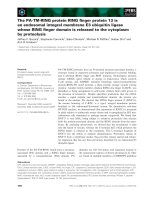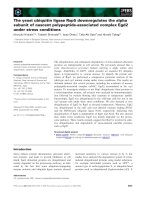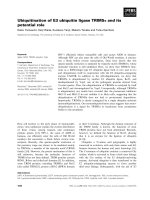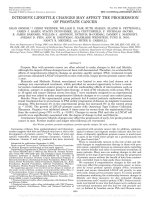E3 ubiquitin ligase, RNF139, inhibits the progression of tongue cancer
Bạn đang xem bản rút gọn của tài liệu. Xem và tải ngay bản đầy đủ của tài liệu tại đây (1.99 MB, 6 trang )
Wang et al. BMC Cancer (2017) 17:452
DOI 10.1186/s12885-017-3438-7
RESEARCH ARTICLE
Open Access
E3 ubiquitin ligase, RNF139, inhibits the
progression of tongue cancer
Lina Wang1,2, Wei Yin1* and Chun Shi2
Abstract
Background: Tongue cancer is still one of the leading causes of mortality around the world. Recently, the ubiquitin
system has been established as a critical modulator of tumors. In order to find the oral cancer related E3 ubiquitin
ligases, we screened the human E3 ubiquitin ligase library and found that RING finger protein 139 (RNF139)
regulated the biological behavior of tongue cancer cells.
Methods: MTT assay was used to analyze the cell viability changes of tongue cancer SCC9 and SCC25 cells caused
by RNF139. The invasion ability of SCC9 and SCC25 cells with or without the knockdown of RNF139 was evaluated
through transwell assay. The immunoblotting was recruited to determine the expression level of RNF139 in human
tongue cancer tissues and para-carcinoma tissues. The effect of RNF139 on tumorigenicity of tongue cancer cells
was analyzed by xenograft model on immunodeficient Balb/c nude mice.
Results: Overexpression of RNF139 inhibits the viability of tongue cancer cells since day 2. The colony formation
ability of SCC9 and SCC25 cells was also decreased with the overexpression of RNF139. Knockdown of RNF139
significantly promoted the invasion ability of SCC9 and SCC25 cells. Furthermore, knockdown of RNF139 also
induced the activation of AKT signaling pathway. While human tongue cancer tissues had low expression of
RNF139. In nude mice, knockdown of RNF139 promoted the tumorigenicity of the SCC25 cells.
Conclusions: Our data establish a role for RNF139 in regulating the progression of tongue cancer.
Keywords: RNF139, Cell viability, Invasion, Tongue cancer, SCC25 cells
Background
Tongue cancer is one of the leading cancers in prevalence
and around 16,400 new American cases are estimated in
2017 [1]. The dysfunction of P53 signaling pathway,
phospho-inositide-3-kinase (PI3K)/v-akt murine thymoma
viral oncogene homolog (AKT) signaling pathway as well
as transforming growth factor-β (TGFβ) signaling pathway
plays a critical role in the carcinogenesis of tongue cancer.
The activity of these signaling pathways is regulated by
post-translational modification.
Ubiquitination is one of the post-translational modification which involves in several cellular activity, including gene transcription, cell-cycle control, DNA repair
and protein degradation [2–5]. It is mediated by the
* Correspondence:
1
The State Key Laboratory Breeding Base of Basic Science of Stomatology
(Hubei-MOST) & Key Laboratory of Oral Biomedicine Ministry of Education,
School & Hospital of Stomatology, Wuhan University, 237 Luoyu road,
Wuhan 430079, China
Full list of author information is available at the end of the article
sequential participated enzymes, E1 ubiquitin activating
enzymes, E2 ubiquitin conjugating enzymes, and E3 ubiquitin ligases [6, 7]. Several E3 ubiquitin ligases have
been confirmed to participate in the pathogenesis of
cancers [8–11]. Although the role of E3 ubiquitin ligases
is still not well-understood, it is continuously being discovered [12–14].
In order to find the oral cancer related E3 ubiquitin ligases, we screened the human E3 ubiquitin ligase library
[12] and found that RING finger protein 139 (RNF139)
regulated the proliferation of tongue cancer cells. In this
study, we further analyzed the role of RNF139 on the development of tongue cancer.
Methods
Reagents and antibodies
Lipofectamine 2000 (Life Technologies), 3-(4,5-dimethylthiazol-2-yl)-2,5-diphenyltetrazolium bromide (MTT)
(Antgene), mouse antibodies against β-actin (Sigma) and
© The Author(s). 2017 Open Access This article is distributed under the terms of the Creative Commons Attribution 4.0
International License ( which permits unrestricted use, distribution, and
reproduction in any medium, provided you give appropriate credit to the original author(s) and the source, provide a link to
the Creative Commons license, and indicate if changes were made. The Creative Commons Public Domain Dedication waiver
( applies to the data made available in this article, unless otherwise stated.
Wang et al. BMC Cancer (2017) 17:452
RNF139 (Santa Cruz); rabbit polyclonal antibodies against
AKT (CST), phospho-AKT (308 and 473) (CST), phosphoFoxO1 (CST), phospho-GSK3β (CST), and phosphomTOR (CST) were purchased from the indicated manufacturers. SCC9 (CRL 1629™), SCC25 (CRL 1628™) and
HEK293 (CRL 1573™) cells were obtained from ATCC.
Cell culture, plasmid and RNAi construction
Human tongue cancer SCC9 and SCC25 cells were
maintained in DMEM medium with the supplement of
10% FBS and 1% Penicillin-Streptomycin. Mammalian
expression plasmids for the RNF139 and RNF139-RNAi
were constructed according to the instructions of molecular cloning: a laboratory manual.
The stable RNF139 overexpression/knockdown SCC9 and
SCC25 cells
The protocol was the same with our previous report [11].
In brief, the RNF139 or RNF139-RNAi retrovirus was
packaged in the HEK293T cells and incubated with SCC9
and SCC25 cells. The retrovirus infected SCC9 and
SCC25 cells were treated with puromycin (0.5 mg/ml) for
7 days before the following experiments.
Cell viability assay
The stable RNF139 overexpression/knockdown SCC9
and SCC25 cells (2 × 103) were seeded on the 96 well
plates. MTT (5 μg/ml) was used and incubated at 37 °C
for 4 h. Then the cells were incubated with Dimethyl
sulfoxide (DMSO) for 30 min. The cell viability was determined by microplate reader at day 2, 4 and 6.
Page 2 of 6
gel electrophoresis and transferred into polyvinylidene
membrane. The membrane was immunoblotted with the
correspondent antibodies and developed with the ECL
reagent.
Xenograft model
Eight-week-old male athymic immunodeficient Balb/c
nude mice were purchased from Shanghai Laboratory
Animal Center. The stable RNF139-knockdown SCC25
(5 × 107) cells were injected subcutaneously into the
flank. Tumor diameters were recorded every 4 days.
Specimens were harvested at 40 days.
Patients and specimen collection
The tumor tissues of tongue cancer patients were collected from Jan. 2016 to Sep. 2016. None of them received any anticancer therapies before surgery. The
diagnosis was based on the pathologically analysis. The
total protein was extracted with the Minute TM Total
Protein Extraction Kit (Inventbiotech).
Statistics
The tumor volume of mice xenograft was analyzed by
two-way ANOVA. One-way ANOVA was used to
analyze the results of cell viability assay, cell invasion assays and colony formation assays. All data were analyzed
by the SPSS package for Windows (Version 18.0,
Chicago, IL). The statistically significant refers to the
P value <0.05.
Results
RNF139 inhibits the viability of tongue cancer cells
Cell invasion assay
The cell invasion assay was performed with the same
procedure [11]. Briefly, after coating with the matrigel
basement membrane matrix, the upper chamber of the
transwell plate was seeded with the stable RNF139 overexpression/knockdown SCC9 and SCC25 cells with
serum-free DMEM medium. The complete DMEM
medium was added into the bottom chamber. They were
incubated at 37 °C for 24 h. After fixing and staining,
the transwell membrane was graphed by Olympus IX71
light microscope.
In order to elaborate the role of RNF139 in regulating the biological behavior of tongue cancer, we analyzed the viability changes of tongue cancer cells,
SCC9 and SCC25 cells, induced by RNF139. The results suggested that overexpression of RNF139 significantly inhibited the viability of SCC9 and SCC25
cells (Fig. 1a). While knockdown RNF139 had the
opposite effects (Fig. 1b). Then we further analyzed
the effect of RNF139 on colony formation ability of
SCC9 and SCC25 cells. As shown in Fig. 1c, the
number of cell colony was also decreased with the
overexpression of RNF139.
Colony formation assay
The stable RNF139 overexpression SCC9 and SCC25
cells were cultured in 10-cm cell dishes for 18 days. The
cell culture medium was changed every other two days.
The cell colonies were stained with crystal violet and
quantified with ImageJ software.
Immunoblotting analysis
Cells were lysed with the lysis buffer (Nonidet P-40
buffer). Protein were seperated with the polyacrylamide
RNF139 regulates the invasion of tongue cancer cells
We next investigated the functions of RNF139 on
cell invasion. The transwell assay was used to analyze
the invasion changes of tongue cancer cells. Knockdown of RNF139 significantly promoted the invasion
ability of SCC9 and SCC25 cells (Fig. 1d). Taken together, these data suggest that RNF139 inhibits cell
viability and invasion of tongue cancer SCC9 and
SCC25 cells.
Wang et al. BMC Cancer (2017) 17:452
Page 3 of 6
Fig. 1 RNF139 regulates the viability, colony formation and invasion of tongue cancer SCC9 and SCC25 cells. a Overexpression of RNF139 inhibits
the viability of SCC9 and SCC25 cells. N = 6. b Knockdown of RNF139 promotes the viability of SCC9 and SCC25 cells. N = 6. c Overexpression of
RNF139 inhibited the colony formation ability of SCC9 and SCC25 cells. N = 3. d Knockdown of RNF139 promoted the invasion of SCC9 and
SCC25 cells. The gel/blots which indicates the efficiency of RNF139 overexpression were the same gel/blots in (a) and (c). The gel/blots which
indicates the efficiency of RNF139 knockdown were the same gel/blots in (b) and (d). N = 3. *:P < 0.05, **:P < 0.01
Human tongue cancer tissues had low expression of
RNF139
To analyze the role of RNF139 in human lung cancers,
we detected the protein level of RNF139 in 23 tongue
cancer patients’ tumor tissues through western blotting.
Most of these patients were 51–70 years old. Squamous
cell carcinoma accounted for 91.30% (21 out of 23). The
protein level of RNF139 was significantly decreased in
the tongue cancer tissues in comparison to paracarcinoma tissues (Fig. 2a&b).
RNF139 promotes activation of AKT1
After determining the correlation between RNF139 and
tongue cancer, we further analyze the regulating mechanism of RNF139 on tongue cancer. We screened the
expression changes of critical components in PI3K-AKT,
JAK-STAT, p53 and MAPK signaling pathway. The AKT
signaling pathway had evident changes with the knockdown of RNF139. As shown in Fig. 3, knockdown of
RNF139 significantly potentiated the phosphorylation of
AKT1 at Ser308 and Ser473, which is the hall mark of
AKT1 activation [28]. Meanwhile, knockdown of
RNF139 also induced the activation of downstream molecules of AKT1, such as mTOR, FoxO1 and GSK3β in
SCC9 and SCC25 cells.
Knockdown of RNF139 promoted the growth of the
tumor xenografts
Next, we performed in vivo xenograft analysis by subcutaneously injecting stable RNF139 knockdown SCC25
Wang et al. BMC Cancer (2017) 17:452
Page 4 of 6
**
-RNF139
- -actin
P1 T1 P2 T2
Fig. 2 Human tongue cancer tissues had low expression of RNF139. a Compared to the para-carcinoma tissues, tongue cancer tissues had low
level of RNF139 protein in tongue cancer patients (N = 23). b The immunoblotting analysis of RNF139 expression in para-carcinoma tissues and
tongue cancer tissues of five tongue cancer patients. P: para-carcinoma tissues, T: tongue cancer tissues
cells into nude mice to further analyze the function of
RNF139. As shown in Fig. 4a, knockdown of RNF139
markedly promoted the volumes of the tumor xenografts.
The histological analysis indicated that the expression of
pAKT1 was strongly increased in the SCC25 cells induced
xenografts with the knockdown of RNF139 (Fig. 4b).
Discussion
Despite advances made in detection and diagnosis as
well as treatments in the past ten years, tongue cancer is
still one of the leading causes of mortality around the
world [12]. The body of the tongue has abundant
Control
RNF139 RNAi
+
-
+
-AKT
-pAKT1(308)
-pAKT1(473)
-p-GSK3
-p-FoxO1
-p-mTOR
- -actin
RNF139
Fig. 3 Knockdown of RNF139 promotes activation of AKT1 signaling
pathway in SCC9 and SCC25 cells. The blots of RNF139 and β-actin
were the same blots in Fig. 1b and d
lymphatic and blood vessel and frequent movement
which promotes the metastasis of tongue cancer. The
impressive progresses achieved in tumor biology make
us realize that each tumor has unique character and
should receive corresponding precision treatment. In the
past decades, patients with breast and lung cancer
already benefited from the personalized treatment which
aimed to treat patients according to their own molecular
characteristics [15, 16]. In order to search the candidate
treatment target for tongue cancer, we focused on the
E3 ubiquitin ligase and screened the human E3 ubiquitin
ligase library. RNF139 as was one of the candidates.
Ubiquitin is a widely existed protein which can be
found in all eukaryotic cells. It consists of 76 amino
acids with an exposed C-terminal. The isopeptide bond
connection between the carboxyl-terminal glycine residue of ubiquitin and an internal K residue or the aminoterminal methionine (M1) of another ubiquitin forms
the polyubiquitin chains. Ubiquitination is indispensable
for several biological processes. Several E3 ubiquitin ligases have been confirmed to be related with initiation
and progression of tumor [12, 13].
E3 ubiquitin ligases mainly include RING and HECT
type E3 ubiquitin ligases. The multimembrane-spanning
protein RNF139 belongs to the RING type E3 ubiquitin
ligases and has a RING-H2 domain with E3 ubiquitin
ligase activity at the COOH-terminal. It locates in the
endoplasmic reticulum (ER) and transfers the ubiquitin
from the E2 ubiquitin conjugating enzymes to substrate.
Previous study suggested that RNF139 could utilize several E2 ubiquitin conjugating enzymes for ubiquitylation.
RNF139 ubiquitinated and degraded the antioxidant enzyme heme oxygenase-1 (HO-1) and suppressed HO-1induced cancer cell growth, migration and invasion [17].
Wang et al. BMC Cancer (2017) 17:452
Page 5 of 6
a
b
Fig. 4 Knockdown of promoted the tumorigenicity of the SCC25 cells. a The growth curve of xenograft tumor model of nude mice which was
originated from the SCC25 cells with or without knockdown of RNF139. b The expression of pAKT1 was increased in the xenografts which was
originated from with the RNF139 stable knockdown SCC25 cells
In this study, we contributed to add another evidence
that RNF139 was a antioncogene protein. We demonstrated that RNF139 was a suppressor of tongue cancer
SCC9 and SCC25 cells growth and invasion. Knockdown
of RNF139 promoted the tumorigenicity of the SCC25
cells. Although we did not find the direct substrate of it,
we observed the significant changes in AKT signaling
pathway which was induced by RNF139. Furthermore,
we determined the low expression of RNF139 in human
tongue cancer tissues. These results support a tumor
suppressor role for RNF139 in tongue cancer.
Conclusions
Our data clearly establish a correlation between RNF139
and tongue cancer. Of clinical relevance is the fact that
our results contribute to the new molecule treatment
targets for tongue cancer.
Abbreviations
AKT: v-akt murine thymoma viral oncogene homolog; DMSO: Dimethyl
sulfoxide; ER: Endoplasmic reticulum; HO-1: Heme oxygenase-1;
PI3K: Phospho-inositide-3-kinase; RNF139: RING finger protein 139;
TGFβ: Transforming growth factor-β
Acknowledgements
We appreciate the patients and their families for participating in this study.
Funding
This study was supported by the National Natural Science Foundation of
China (81501750), the open research fund program of Hubei-MOST KLOS &
KLOBME (201601) and and the Natural Scientific Foundation of Liaoning
(2014023037). The foundation had no role in the design of the study and
collection, analysis, and interpretation of data and in writing the manuscript.
Availability of data and materials
The data that support the findings of this study are available from the
corresponding author on reasonable request.
Authors’ contributions
LNW, CS and WY designed the study, performed the study and analyzed the
data. WY wrote the main manuscript. All authors read and approved the final
Wang et al. BMC Cancer (2017) 17:452
manuscript. WY is accountable for all aspects of the work in ensuring that
questions related to the accuracy or integrity of any part of the work are
appropriately investigated and resolved.
Ethics approval and consent to participate
This study was conducted in accordance with the amended Declaration of
Helsinki. This study was approved by the Institutional Review Board (IRB) of
the Hospital and School of Stomatology, Wuhan University (201621). Written
informed consent was obtained from all participants. The animal research
was approved by the Institutional Review Board (IRB) of the Hospital and
School of Stomatology, Wuhan University (201621). The methods were
carried out in accordance with the approved guidelines. The xenograft
animal experiments were in accordance with animal ethical care guidelines.
Page 6 of 6
14. Voutsadakis IA. Ubiquitination and the ubiquitin - proteasome system in the
pathogenesis and treatment of squamous head and neck carcinoma.
Anticancer Res. 2013;33(9):3527–41.
15. Yang Y, Yin W, He W, Jiang C, Zhou X, Song X, et al. Phenotype-genotype
correlation in multiple primary lung cancer patients in China. Sci Rep.
2016;6:36177.
16. Yang Y, Shi C, Sun H, Yin W, Zhou X, Zhang L, et al. Elderly male smokers
with right lung tumors are viable candidates for KRAS mutation screening.
Sci Rep. 2016;6:18566.
17. Lin PH, Lan WM, Chau LY. TRC8 suppresses tumorigenesis through
targeting heme oxygenase-1 for ubiquitination and degradation.
Oncogene. 2013;32:2325–34.
Consent for publication
Not applicable.
Competing interests
The authors declare that they have no competing interests.
Publisher’s Note
Springer Nature remains neutral with regard to jurisdictional claims in
published maps and institutional affiliations.
Author details
1
The State Key Laboratory Breeding Base of Basic Science of Stomatology
(Hubei-MOST) & Key Laboratory of Oral Biomedicine Ministry of Education,
School & Hospital of Stomatology, Wuhan University, 237 Luoyu road,
Wuhan 430079, China. 2Department of Endodontics, College of Stomatology,
Dalian Medical University, Dalian 116044, China.
Received: 1 February 2017 Accepted: 20 June 2017
References
1. Siegel RL, Miller KD, Jemal A. Cancer statistics, 2017. CA Cancer J Clin.
2017;67(1):7–30.
2. Lan X, Atanassov BS, Li W, Zhang Y, Florens L, Mohan RD, et al. USP44 is an
integral component of N-CoR that contributes to Gene repression by
deubiquitinating histone H2B. Cell Rep. 2016;17:2382–93.
3. Lim KH, Song MH, Baek KH. Decision for cell fate: deubiquitinating enzymes
in cell cycle checkpoint. Cell Mol Life Sci. 2016;73:1439–55.
4. Wang Y, Zhang N, Zhang L, Li R, Fu W, Ma K, et al. Autophagy regulates
chromatin ubiquitination in DNA damage response through elimination of
SQSTM1/p62. Mol Cell. 2016;63:34–48.
5. Bhogaraju S, Kalayil S, Liu Y, Bonn F, Colby T, Matic I, et al. Phosphoribosylation
of ubiquitin promotes serine ubiquitination and impairs conventional
ubiquitination. Cell. 2016;167:1636–49.
6. Li J, Chai QY, Liu CH. The ubiquitin system: a critical regulator of
innate immunity and pathogen-host interactions. Cell Mol Immunol.
2016;13(5):560–76.
7. Xu D, Wang H, You G. Posttranslational regulation of organic anion
transporters by ubiquitination: known and novel. Med Res Rev. 2016;36:964–79.
8. Ji W, Rivero F. Atypical Rho GTPases of the RhoBTB Subfamily: Roles in
Vesicle Trafficking and Tumorigenesis. Cells. 2016;5 pii: E28.
9. Lazzari E, Meroni G. TRIM32 ubiquitin E3 ligase, one enzyme for several
pathologies: from muscular dystrophy to tumours. Int J Biochem Cell Biol.
2016;79:469–77.
10. Dallavalle C, Albino D, Civenni G, Merulla J, Ostano P, Mello-Grand M, et al.
MicroRNA-424 impairs ubiquitination to activate STAT3 and promote
prostate tumor progression. J Clin Invest. 2016;126:4585–602.
11. Zhang X, Li CF, Zhang L, Wu CY, Han L, Jin G, et al. TRAF6 restricts p53
mitochondrial translocation, apoptosis, and tumor suppression. Mol Cell.
2016;64:803–14.
12. Wang L, Wang X, Zhao Y, Niu W, Ma G, Yin W, et al. E3 ubiquitin ligase
RNF126 regulates the progression of tongue cancer. Cancer Med.
2016;5:2043–7.
13. Jin J, Zhao L, Li Z. The E3 ubiquitin ligase RNF135 regulates the tumorigenesis
activity of tongue cancer SCC25 cells. Cancer Med. 2016;5:3140–6.
Submit your next manuscript to BioMed Central
and we will help you at every step:
• We accept pre-submission inquiries
• Our selector tool helps you to find the most relevant journal
• We provide round the clock customer support
• Convenient online submission
• Thorough peer review
• Inclusion in PubMed and all major indexing services
• Maximum visibility for your research
Submit your manuscript at
www.biomedcentral.com/submit









